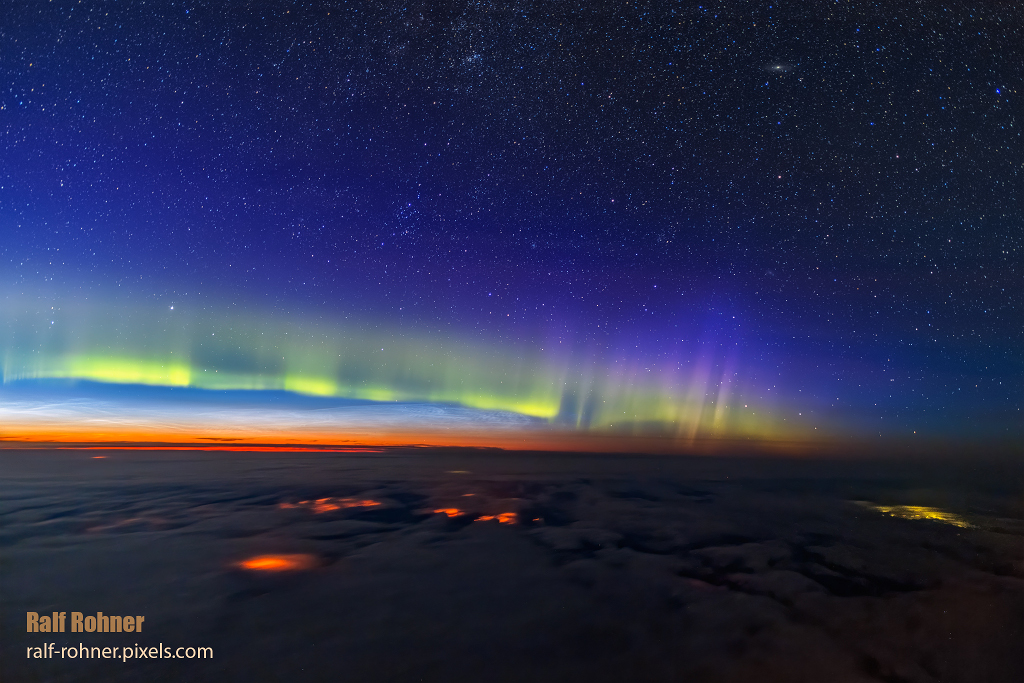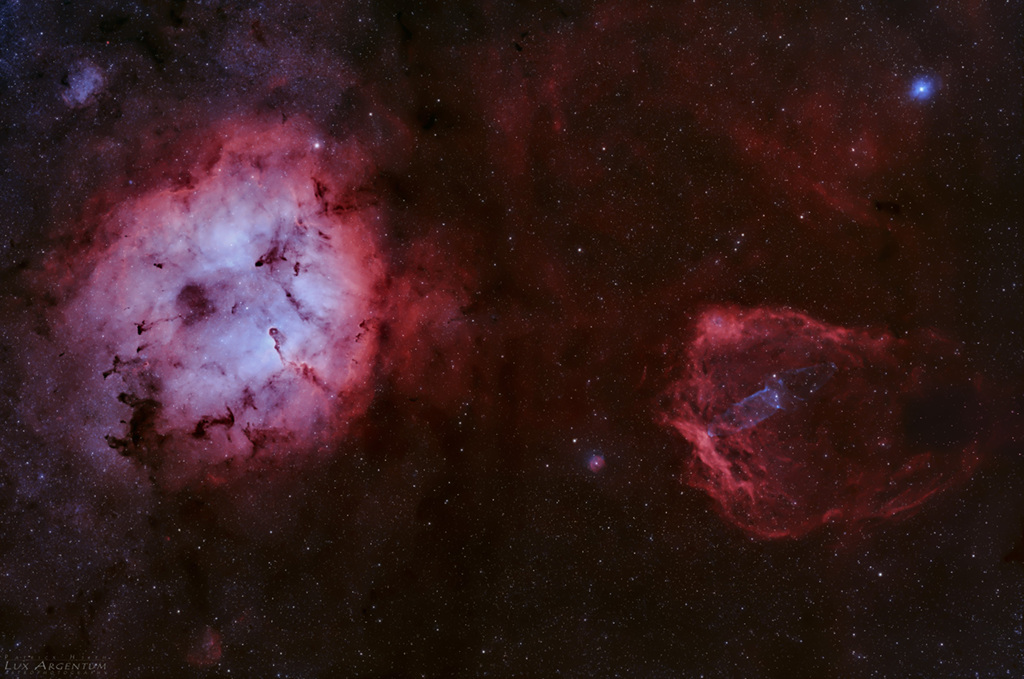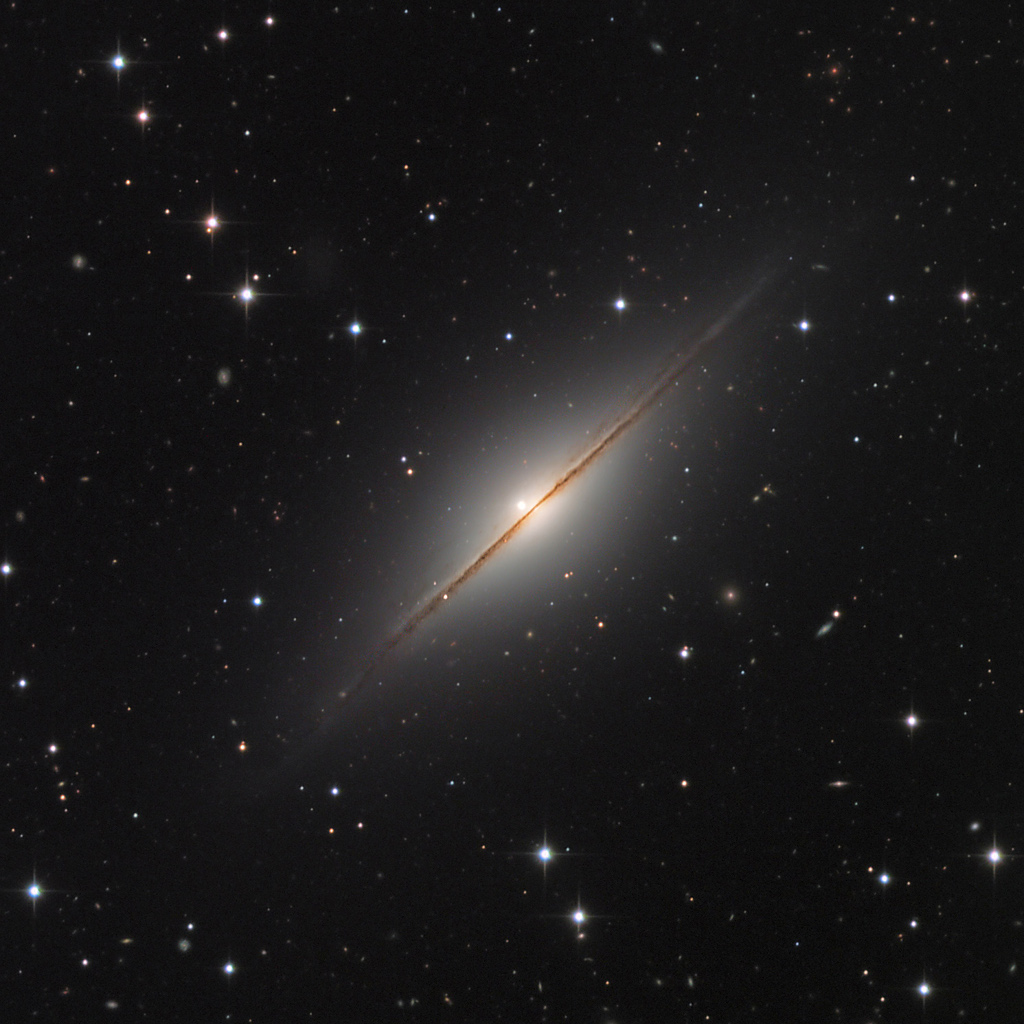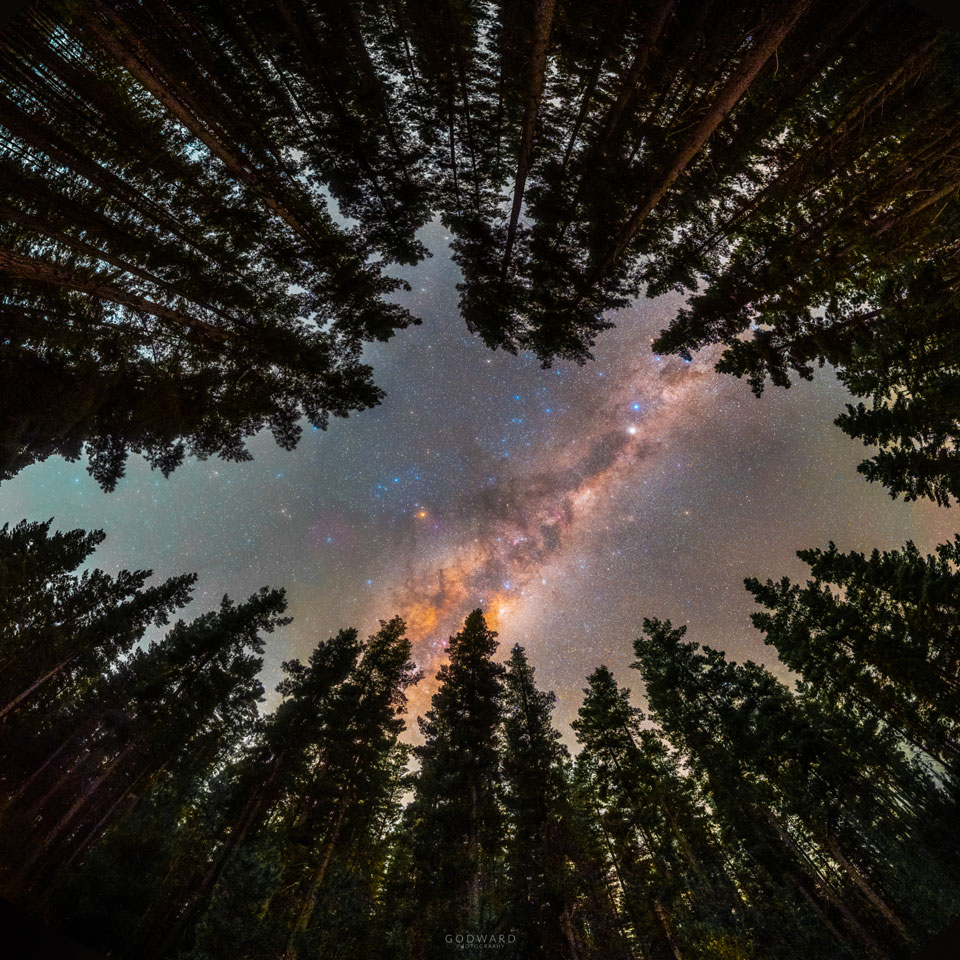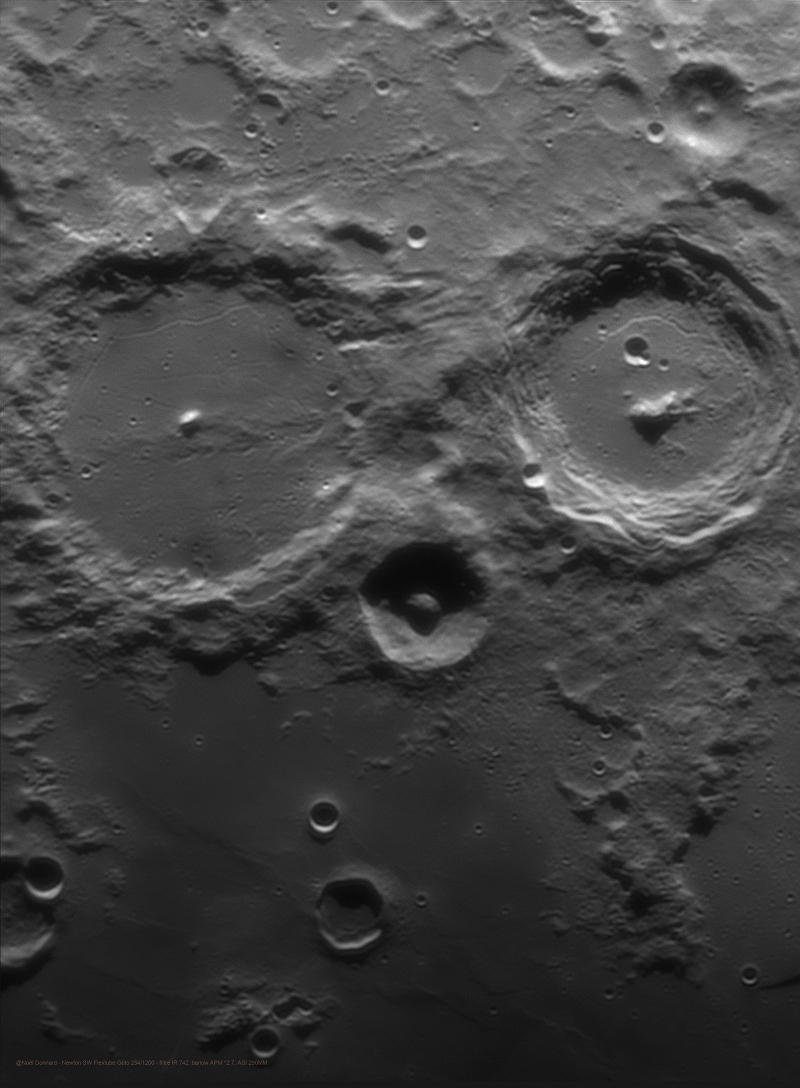Nombre total de pages vues
24/07/2021
ASTRONOMY - The Edge of Space
2021 July 24
Image Credit & Copyright: Ralf Rohner
Explanation: Where does space begin? For purposes of spaceflight some would say at the Karman line, currently defined as an altitude of 100 kilometers (60 miles). Others might place a line 80 kilometers (50 miles) above Earth's mean sea level. But there is no sharp physical boundary that marks the end of atmosphere and the beginning of space. In fact, the Karman line itself is near the transition between the upper mesophere and lower thermosphere. Night shining or noctilucent clouds are high-latitude summer apparitions formed at altitudes near the top of the mesophere, up to 80 kilometers or so, also known as polar mesopheric clouds. Auroral bands of the northern (and southern) lights caused by energetic particles exciting atoms in the thermosphere can extend above 80 kilometers to over 600 kilometers altitude. Taken from a cockpit while flying at an altitude of 10 kilometers (33,000 feet) in the realm of stratospheric aeronautics, this snapshot captures both noctilucent clouds and aurora borealis under a starry sky, looking toward planet Earth's horizon and the edge of space.
23/07/2021
ASTRONOMY - Elephant, Bat, and Squid
2021 July 23
Image Credit & Copyright: Patrick Hsieh
Explanation: Sprawling emission nebulae IC 1396 and Sh2-129 mix glowing interstellar gas and dark dust clouds in this 10 degree wide field of view toward the northern constellation Cepheus the King. Energized by its bluish central star IC 1396 (left) is hundreds of light-years across and some 3,000 light-years distant. The nebula's intriguing dark shapes include a winding dark cloud popularly known as the Elephant's Trunk below and right of center. Tens of light-years long, it holds the raw raw material for star formation and is known to hide protostars within. Located a similar distance from planet Earth, the bright knots and swept back ridges of emission of Sh2-129 on the right suggest its popular name, the Flying Bat Nebula. Within the Flying Bat, the most recently recognized addition to this royal cosmic zoo is the faint bluish emission from Ou4, the Giant Squid nebula.
22/07/2021
ASTRONOMY - NGC 7814: Little Sombrero with Supernova
2021 July 22
Image Credit & Copyright: CHART32 Team,
Explanation: Point your telescope toward the high flying constellation Pegasus and you can find this expanse of Milky Way stars and distant galaxies. NGC 7814 is centered in the pretty field of view that would almost be covered by a full moon. NGC 7814 is sometimes called the Little Sombrero for its resemblance to the brighter more famous M104, the Sombrero Galaxy. Both Sombrero and Little Sombrero are spiral galaxies seen edge-on, and both have extensive halos and central bulges cut by a thin disk with thinner dust lanes in silhouette. In fact, NGC 7814 is some 40 million light-years away and an estimated 60,000 light-years across. That actually makes the Little Sombrero about the same physical size as its better known namesake, appearing smaller and fainter only because it is farther away. In this telescopic view from July 17, NGC 7814 is hosting a newly discovered supernova, dominant immediately to the left of the galaxy's core. Cataloged as SN 2021rhu, the stellar explosion has been identified as a Type Ia supernova, useful toward calibrating the distance scale of the universe.
19/07/2021
ASTRONOMY - Framed by Trees: A Window to the Galaxy
2021 July 19
Image Credit & Copyright: Will Godward
Explanation: The photographer had this shot in mind for some time. He knew that objects overhead are the brightest -- since their light is scattered the least by atmospheric air. He also that knew the core of our Milky Way Galaxy was just about straight up near midnight around this time of year in South Australia. Chasing his mental picture, he ventured deep inside the Kuipto Forest where tall radiata pines blocked out much of the sky -- but not in this clearing. There, through a window framed by trees, he captured his envisioned combination of local and distant nature. Sixteen exposures of both trees and the Milky Way Galaxy were recorded. Antares is the bright orange star to left of our Galaxy's central plane, while Alpha Centauri is the bright star just to the right of the image center. The direction toward our Galaxy's center is below Antares. Although in a few hours the Earth's rotation moved the Galactic plane up and to the left -- soon invisible behind the timber, his mental image was secured forever -- and is featured here.
17/07/2021
ASTRONOMY - Alphonsus and Arzachel
Image Credit & Copyright: Noel Donnard
Explanation: Point your telescope at tonight's first quarter Moon. Along the terminator, the shadow line between night and day, you might find these two large craters staring back at you with an owlish gaze. Alphonsus (left) and Arzachel are ancient impact craters on the north eastern shores of Mare Nubium, the lunar Sea of Clouds. The larger Alphonsus is over 100 kilometers in diameter. A low sun angle highlights the crater's sharp 1.5 kilometer high central peak in bright sunlight and dark shadow. Scouting for potential Apollo moon landing sites, the Ranger 9 spacecraft returned closeup photographs of Alphonsus before it crashed in the crater just northeast (left) of its central mountain in 1965. Alpetragius, between Alphonsus and Arzachel, is the small crater with the deeply shadowed floor and overly large central peak.
16/07/2021
ASTRONOMY - Love and War by Moonlight
2021 July 16
Image Credit & Copyright: Shi Huan
Explanation: Venus, named for the Roman goddess of love, and Mars, the war god's namesake, come together by moonlight in this serene skyview, recorded on July 11 from Lualaba province, Democratic Republic of Congo, planet Earth. Taken in the western twilight sky shortly after sunset the exposure also records earthshine illuminating the otherwise dark surface of the young crescent Moon. Of course the Moon has moved on. Venus still shines in the west though as the evening star, third brightest object in Earth's sky, after the Sun and the Moon itself. Seen here above a brilliant Venus, Mars moved even closer to the brighter planet and by July 13 could be seen only about a Moon's width away. Mars has since slowly wandered away from much brighter Venus in the twilight, but both are sliding toward bright star Regulus. Alpha star of the constellation Leo, Regulus lies off the top of this frame and anticipates a visit from Venus and then Mars in twilight skies of the coming days.
15/07/2021
SANTé/MéDECINE - Le cancer
ASTRONOMY - GW200115: Simulation of a Black Hole Merging with a Neutron Star
2021 July 14
Video Credit: Simulation: S.V. Chaurasia (Stockholm U.), T. Dietrich (Potsdam U. & MPIGP);
Visualization: T. Dietrich (Potsdam U. & MPIGP), N. Fischer, S. Ossokine, H. Pfeiffer (MPIGP)
Explanation: What happens when a black hole destroys a neutron star? Analyses indicate that just such an event created gravitational wave event GW200115, detected in 2020 January by LIGO and Virgo observatories. To better understand the unusual event, the featured visualization was created from a computer simulation. The visualization video starts with the black hole (about 6 times the Sun's mass) and neutron star (about 1.5 times the Sun's mass) circling each other, together emitting an increasing amount of gravitational radiation. The picturesque pattern of gravitational wave emission is shown in blue. The duo spiral together increasingly fast until the neutron star becomes completely absorbed by the black hole. Since the neutron star did not break apart during the collision, little light escaped -- which matches the lack of an observed optical counterpart. The remaining black hole rings briefly, and as that dies down so do the emitted gravitational waves. The 30-second time-lapse video may seem short, but it actually lasts about 1000 times longer than the real merger event.
13/07/2021
ASTRONOMY - Saturn's Iapetus: Painted Moon in 3D
2021 July 13
Image Credit: NASA, ESA, JPL, SSI, Cassini Imaging Team; 3D Rendering: NASA's VTAD
Explanation: What has happened to Saturn's moon Iapetus? Vast sections of this strange world are dark brown, while others are as bright white. The composition of the dark material is unknown, but infrared spectra indicate that it possibly contains some dark form of carbon. Iapetus also has an unusual equatorial ridge that makes it appear like a walnut. To help better understand this seemingly painted moon, NASA directed the robotic Cassini spacecraft orbiting Saturn to swoop within 2,000 kilometers in 2007. Iapetus is pictured here in 3D. A huge impact crater seen in the south spans a tremendous 450 kilometers and appears superposed on an older crater of similar size. The dark material is seen increasingly coating the easternmost part of Iapetus, darkening craters and highlands alike. Close inspection indicates that the dark coating typically faces the moon's equator and is less than a meter thick. A leading hypothesis is that the dark material is mostly dirt leftover when relatively warm but dirty ice sublimates. An initial coating of dark material may have been effectively painted on by the accretion of meteor-liberated debris from other moons.
SANTé/MEDECINE - LA GUERISON DU CANCER : Un espoir immense - La troisième voie -2/7-
Reprogrammer le cancer, fantasme ou réalité scientifique ? Oui, cancer. Le mot qui crispe, le monstre tentaculaire qui hante les statistique...

-
2022 September 26 All the Water on Planet Earth Illustration Credit: Jack Cook, Adam Nieman, Woods Hole Oceanographic Institution ; Data ...
-
2025 January 14 North Star: Polaris and Surrounding Dust Image Credit & Copyright: Davide Coverta Explanation: Why is Polaris called ...

